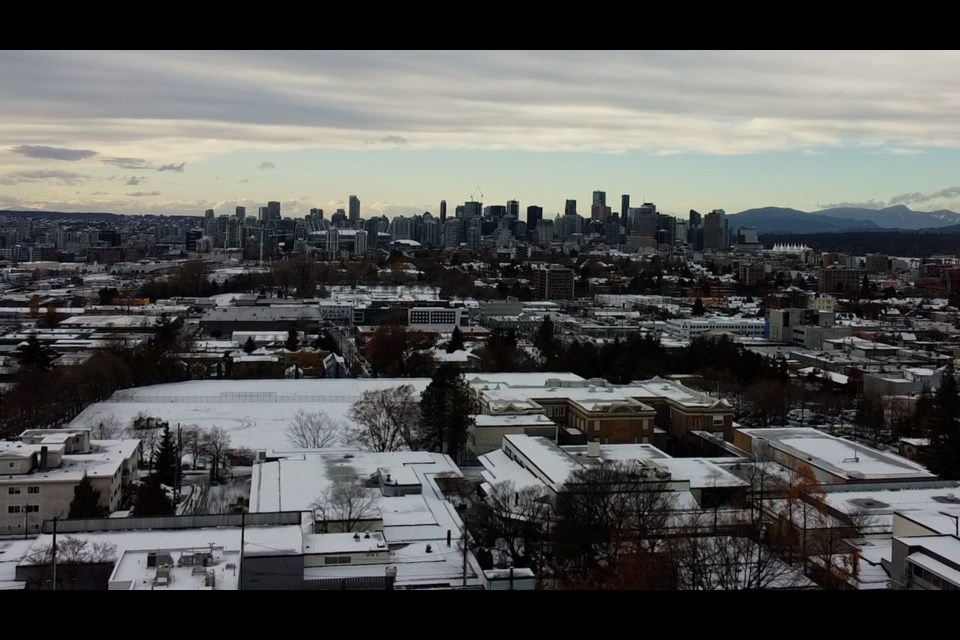When it comes to snow removal, the Lower Mainland is a bit of a jurisdictional jigsaw puzzle.
Two local politicians are hoping to better position what is, arguably, the biggest piece: the province’s Ministry of Transportation, which oversees highways, including key Fraser River crossings.
“The snow that hit us on Tuesday wasn’t a surprise,” said New Westminster councillor Daniel Fontaine.
“But the impact was a complete shutdown that closed roads and bridges and really brought much of the Lower Mainland to a complete halt. I think it’s important to know why, and to work on a regional plan that does better next time. This has to be a combined effort of the province and local municipalities across the Lower Mainland,” said Fontaine.
Joining Fontaine in a call for a “snow summit” is Surrey councillor Linda Annis, who said she was stuck in traffic for over eight hours Tuesday night, when bridge and tunnel closures prevented her from getting to South Surrey, from downtown Vancouver, until close to 5 a.m.
“The gridlock spread so quickly and suddenly that we were all trapped in our cars for hours as the weather and traffic got worse. How do other regions across Canada and the United States that get much more snow than us keep going, and what can we learn going forward? We have to get better at this and we have to do it together,” said Annis.
The two are suggesting Metro Vancouver regional government chair George Harvie and B.C. Minister of Transportation Rob Fleming chair the summit to find ways of preventing further chaos.
Fleming has been absent from social media since snow began to fall Tuesday and has not addressed media since. It’s unclear where Fleming is.
On Wednesday, the ministry claimed the key problem at the Alex Fraser Bridge was congestion caused by people leaving work early.
The traffic volume was compounded by the closure of one lane in each direction for de-icing of bridge cables. The ministry dismissed claims the bridge was inadequately prepared for the storm, saying a “full force” of equipment was used; rather, the sheer amount of snow in a short period of time contributed to car accidents on the bridge deck.
However, it was high winds and blowing snow that subsequently forced the bridge’s closure beyond the accidents, the ministry claimed.
Fontaine said the ministry and municipalities may be able to come up with a better plan at the summit, to address bottlenecks.
“The minimum we can do as leaders is bring together people most responsible for this file,” said Fontaine.
Over two dozen entities handle snow removal in Lower Mainland
The Metro Vancouver regional government consists of 21 municipalities plus the University Endowment Lands and Tsawwassen First Nation.
In addition, there are Indigenous bands, such as Squamish First Nation on the North Shore, that perform their own work to connect roads to neighbouring municipalities.
Then there are further niche entities such as the Vancouver Park Board that is tasked to clear streets in city parks, such as Stanley Park; and the University of B.C. and Simon Fraser University, which are responsible for connecting throughfares and campus streets.
All of these jurisdictions are in charge of snow removal for their streets. This means they typically must coordinate snow removal along connecting routes.
Furthermore, the ministry’s highway-clearing responsibilities cut across nearly all these jurisdictions and are performed by contractor Mainroad Group.
Perhaps the most explicit example of inter-jurisdictional snow removal is a roughly two-kilometre stretch of Marine Drive where it crosses the north ramp Lion’s Gate Bridge. A driver coming from the west may see plows from West Vancouver, Mainroad Group (as the street becomes part of Highway 99), the District of North Vancouver and City of North Vancouver.
Fontaine’s New Westminster streets directly connect with four neighbours (Richmond, Delta, Burnaby and Coquitlam), or five if Surrey is counted by way of the ministry-managed Pattullo Bridge.
“My sense of it is where cities butt up against each other, that didn’t seem to be the pinch points we saw. … Where things get more complex is when you have provincial highways and on- and off-ramps that fall in your jurisdiction,” said Fontaine.




